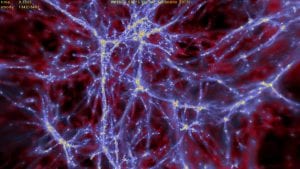FIREBox
 FIREBox is a next-generation extension of FIRE which will simulate full cosmological volumes at the resolution of the FIRE zoom-in simulations. FIREBox will provide the galaxy statistics necessary to fully interpret galaxy surveys and will be ideally suited for studies of the intergalactic medium.
FIREBox is a next-generation extension of FIRE which will simulate full cosmological volumes at the resolution of the FIRE zoom-in simulations. FIREBox will provide the galaxy statistics necessary to fully interpret galaxy surveys and will be ideally suited for studies of the intergalactic medium.
Motivation:
Observational surveys that cover large fractions of the sky and sample millions of galaxies have been instrumental in quantifying the statistics of galaxy properties and in measuring their evolution across cosmic time. Hydrodynamic simulations of large cosmological volumes have been paramount in connecting these results to galaxy formation theory. However, these cosmological simulations model core physical processes (such as star formation, stellar feedback, and supermassive black hole growth) using finely tuned sub-grid prescriptions, reducing their predictive power and compromisingtheir ability to adequately capture the internal structure of galaxies. Zoom-in simulations like FIRE can implement much more detailed models of the interstellar medium (ISM), but have historically been limited in the number of galaxies and volume of the inter-galactic medium that can be simulated.
FIREbox consists of two flagship simulations designed to bridge the gap between current large-volume and zoom-in simulations. The high numerical resolution (comparable to state-of-the-art zoom-ins of Milky Way-mass galaxies) and the relatively large volume (similar to some of the smaller cosmological box simulations) makes FIREbox an ideal tool to study a variety of science questions (see below).
FIREbox is essentially a “non-zoomed in” FIRE-2 simulation: the physics and numerics are identical to the FIRE-2 zoom-in simulations, but rather than sampling only a small sub-volume or “patch” of the large cosmological “box” in which the simulation runs at high resolution, we fill the entire box with equal (high-resolution) elements, so we’re sampling everything at high resolution at once.
Discovery Space:

This image shows a comparison of the FIREbox simulations (red stars) with state-of-the-art large- volume simulations (lower right half of the plot) and zoom-in runs of Milky Way Mass or larger halos (upper left half of the plot) in terms of effective box size (to the right is better) and mass resolution (upward is better). Note that the FIRE zoom-ins of dwarfs can reach (several) orders-of-magnitude better resolution (up to ~10 solar masses and <0.1 parsec), but also have smaller box sizes (<1 Mpc). Diagonal dashed lines indicate constant numbers of particles for large-volume runs. FIREbox reaches extremely high numerical resolution matching (or exceeding) the resolution of some contemporary zoom-in simulations.
Science Goals:
The numerical resolution, comparably large sample size (~1000 dwarf galaxies at z=2, ~50 MWs at low redshift), and the lack of boundary effects makes FIREbox a potentially powerful data set to study the evolution of galaxies in a cosmological context, with extended statistics. Among the primary goals, this can be a particularly valuable supplement to higher-resolution but limited-statistics/volume “zoom-in” simulations in areas like:
- The distribution and enrichment of the IGM, CGM, and ISM: this includes a variety of topics where observers are probing ever-further from galaxies, requiring large volumes in simulations to probe and robustly predict inter-galactic gas properties including: HI covering fractions and metal absorption line distributions, the enrichment of intergalactic gas and behavior of inflows and outflows, the role of galaxy interactions and mergers, and interactions between inflows and galactic winds in the “baryon cycle”
- Low mass galaxies: while the resolution in isolated zoom-in runs will always be superior for low-mass galaxies, with a large volume we can study the impact of different environments (e.g. galactic winds and ionizing radiation) and behavior during re-ionization
- Links between galaxy and halo growth: looking at the co-evolution of galaxy masses and sizes, and environmental dependence of these and other galaxy properties
- Growth and Evolution of Black holes (SMBHs): studying gas accretion from the IGM to central SMBHs, and co-evolution of galaxy and central SMBHs
Some images of the preliminary FIREbox simulations, zooming into the structure of the gas (blue/yellow) and stars (red points) to various degrees (the run here is the low-resolution test box, at redshift z=2).


